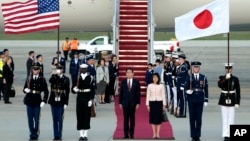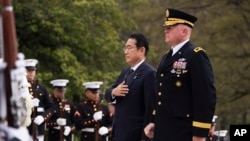President Joe Biden is set to welcome Japanese Prime Minister Fumio Kishida to the White House Tuesday evening for an official visit that will mark one of the biggest structural upgrades of the U.S.-Japan security alliance in several decades.
The visit will also usher in Tokyo’s further integration into Washington’s security framework with other allies in the region, a key factor to deter Beijing.
The visit will “highlight the high ambition of our alliance,” said national security adviser Jake Sullivan during a White House briefing Tuesday.
Biden and Kishida will announce measures to enhance “defense and security cooperation to enable greater coordination and integration of our forces and ensure that they're optimally postured and linked to other like-minded partners,” Sullivan said.
“There will be major deliverables on space as we lead the way on space exploration and returning to the moon,” he added. “There will be announcements of significant research partnerships between our leading institutions on critical and emerging technologies such as AI [artificial intelligence], quantum semiconductors, and clean energy.”
The measures announced will first time will allow the United States and Japan to collaborate more closely on the development and potentially co-production of vital military and defense equipment, said Deputy Secretary of State Kurt Campbell in a recent event hosted by the Center for a New American Security.
It's a milestone in the U.S. alliance with Japan, what Campbell describes as the “cornerstone of our engagement in the Indo-Pacific.”
The plan is set to declare their intention to modernize a framework that has for decades guided interaction between Japan's Self-Defense Forces and the approximately 54,000 U.S. troops in Japan.
Tokyo wants the U.S. military to strengthen the functions of its command headquarters in Japan to allow for better coordination. Under the current system, major decisions are coordinated with the U.S. military's Indo-Pacific Command, located more than 6,000 kilometers (3,728 miles) and five time zones away in Hawaii.
Under its new national security strategy, Japan is establishing a joint operational command for its self-defense force, said Tetsuo Kotani, senior fellow at the Japan Institute of International Affairs.
“In that sense we have done our homework and now it’s time for the United States to upgrade their command-and-control structure in the Indo-Pacific,” he told VOA.
Broader regional frameworks
The leaders agree on the goal of expanding bilateral security ties into broader regional frameworks with other U.S. allies, including the Philippines and Australia.
The pair will be joined later this week by Philippines President Ferdinand Marcos Jr. in a summit set to bolster trilateral maritime cooperation in the South China Sea. An announcement on some form of trilateral joint naval patrol activity is widely expected.
Sullivan confirmed to VOA the widely expected announcement of trilateral joint naval patrols, a move that is likely to trigger a strong reaction from Beijing.
“We just saw ‘trilateral plus Australia’ new form of quadrilateral joint naval patrols last week, so you can expect to see more of that in the future,” he said.
Beyond bolstering naval defense amid Beijing’s ramped-up aggression in the South China Sea, Tokyo has signaled it wants to link Japan into a broader integrated air and missile defense network with the U.S. and Australia.
“Pushing ahead on cooperation with like-minded countries on security, including defense equipment and technology, will lead to the establishment of a multilayered network, and by expanding that we can improve deterrence,” Kishida said Friday.
Considering the difficulties of integrating such systems, talks will likely begin with establishing greater situational awareness among the three countries for their individual air and missile defenses, said Jeffrey Hornung, the Japan Lead for the RAND National Security Research Division and a senior political scientist at RAND.
“Any cooperation on this front will help dilute Chinese anti-access, area denial efforts by enabling the three countries to pass information on Chinese activities,” he told VOA.
Japan’s AUKUS role
In response to VOA’s question, Sullivan also confirmed the pair will discuss Japan’s potential involvement in AUKUS, a trilateral security partnership formed in 2021 among the U.S., Australia and the United Kingdom.
“We're prepared to work with additional partners beyond the three of us, where they can bring capabilities,” Sullivan said. “Japan is one of the countries that could very well bring capabilities to that, so we will explore a partnership with Japan under Pillar II of AUKUS as well as other partners.”
In a joint statement published Tuesday by the British government, the group said they are “considering cooperation with Japan on AUKUS Pillar II advanced capability projects,” in recognition of Japan's strengths and its close bilateral defense partnerships with all three countries.
“Pillar II” of AUKUS is focused on delivering advanced capabilities and sharing technologies across a range of areas including quantum computing, undersea, hypersonic, artificial intelligence and cyber technology. The step takes the group’s effort to push back against China beyond its first pillar – delivery of nuclear-powered attack submarines to Australia, for which there are no known plans to include Japan.
Any multinational defense industrial partnership is an extremely complicated endeavor, said Yuki Tatsumi, director of the Japan Program at the Stimson Center.
Many aspects need to be harmonized, from industrial security standards and export licensing regulations to the arrangement on intellectual property rights, she told VOA. “Making it a reality will take many months of careful consultation among all four countries.”
Nippon Steel
A potential rift remains between Biden and Kishida over the proposed sale of Pittsburgh-based U.S. Steel to Nippon Steel of Japan, a deal that has become embroiled in protectionist campaign rhetoric ahead of the November U.S. presidential election.
Last month Biden announced his opposition to the deal, saying the U.S. needs to “maintain strong American steel companies powered by American steelworkers.” His prospective opponent, former President Donald Trump, has promised to block the $14 billion deal if he is elected again.
The optics of a Japanese firm trying to buy an American manufacturing company during an election year is bad for Biden, Tatsumi said, and the pair will want to avoid airing their differences publicly.
In a Tuesday event hosted by the Center for Strategic and International Studies, U.S. Ambassador to Japan Rahm Emanuel sought to downplay the impact of Biden’s opposition to the U.S. Steel acquisition to the relationship.
He noted that in February the Biden administration approved a plan that would drive billions of dollars in revenue to a U.S.-based subsidiary of the Japanese company Mitsui for crane production in the United States.
Kishida and Japanese first lady Yuko Kishida will be briefly welcomed at the White House on Tuesday evening ahead of Wednesday’s official visit and formal state dinner, the fifth that Biden will have hosted since taking office in 2021.
VOA’s William Gallo contributed to this report.












